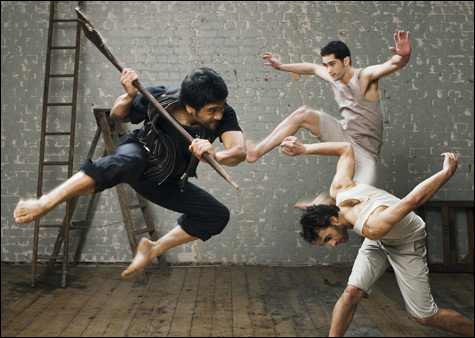
BLACK GRACE DANCE COMPANY: Multicultural fusion in celebration of what it means to be a Pacific Islander. |
Somewhere in the middle of Stephen Petronio’s terrific hour-long dance I Drink the Air Before Me last Friday night, the dancers exited and the space went dark. For a minute or so, we gazed through a scrim at the harbor beyond the ICA’s back wall: a dark expanse of calm water and sky, a string of lights on the other shore. It was an interval of stillness in the midst of turbulence, like the eye of a storm.
Except for that moment of communing with the landscape, I didn’t think of the dance as being about weather at all — Petronio’s stated theme — or even about natural phenomena, except in the sense of what extraordinary dancers can do. I Drink the Air felt like an encounter between mundane and super-specialized ways of dancing. The interplay was so continuous and fast-moving that eventually the two æsthetics merged into one. Which I guess is another way of describing Petronio’s movement style.
When the dance begins, a woman in a black cape with black-and-white striped tights underneath stalks into the space. As she performs, with odd, slow stretches and bends, other dancers appear, all dressed in white tights and black raincoats. The woman in the cape continues dancing, but the others move in counterpoint to her, springing sideward, carving the space with their arms and torsos, holding long balances together. I’m aware of rather ominous music playing — probably some chordal combination of instruments you don’t usually hear together, and a treble choir singing something I can’t understand in a minor key.
All this sets the stage for drama, but no further developments of that kind occur. The woman in the cape doesn’t produce a dagger; the people in the raincoats don’t form a lynch mob. What the 10 dancers do pull off is a spectacle that constantly refreshes itself with deeper explorations of movement, new designs and groupings, and new energies.
The woman in the cape goes on dancing her solo. Eventually she’s working against small groups of two and three other dancers, to make for a multi-layered counterpoint. In an invisible transition, two of the other women take up the soloist’s movement, opting out of the regrouping and rearranging schemes of the rest. The density of the stage seems to shift. Nothing is made of this.
The dance is divided into sections roughly related to Nico Muhly’s score, which uses minimalist repeated motifs and accumulating textures that recall Steve Reich and Philip Glass, exclamatory post-minimalist gestures, a splash of interlocking gamelan rhythms, and some electronic enhancement. A bassoon throws syncopated shouts against ostinato strings. A trombone quacks while the strings are plucked and the piano joins in.
As the dance goes on, the group seems to lose its coherence. The first formal patterns splinter into what seem like unruly, pressured crowds crossing and recrossing the space in a rush. These onslaughts could be more organized than I think, because my attention is drawn instead to the solos and duets that they leave behind. Same-sex and male-female duos partner each other in two-handed swings and tangles. They maneuver into architectural poses that hold for a second and break apart; they pitch into sudden cantilevered lifts. One at a time or in concert with one or two others, they modulate from flung-out, uncontrolled swipes and swings to perfectly modeled shapings. Barefoot, they speed through ballet steps: jetés, assemblés with turns in the air, pas de chat, and long, steady balances on half-toe. Many of the academic moves are skewed by their tilting torsos or embellished by arms that spiral or stretch out around the body.